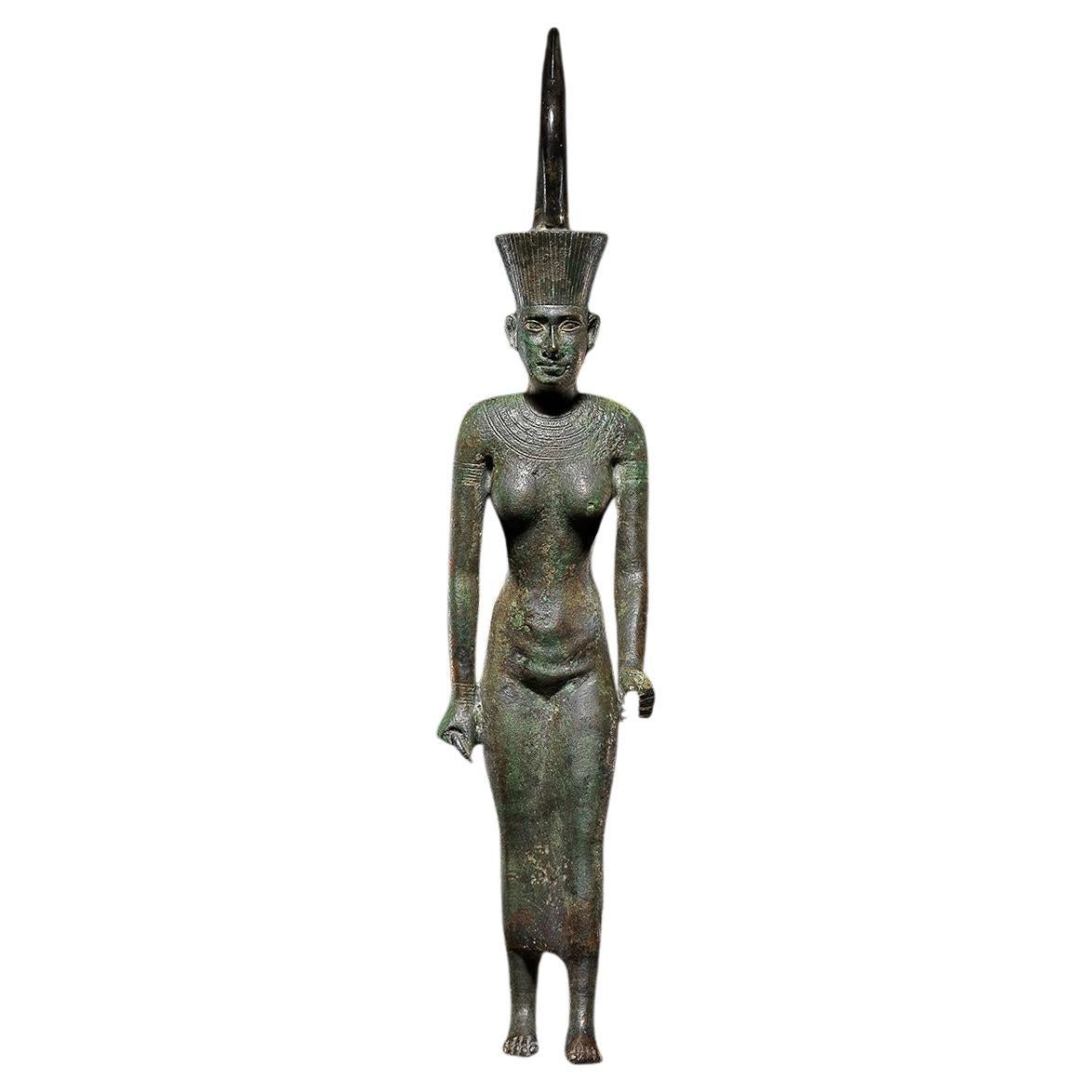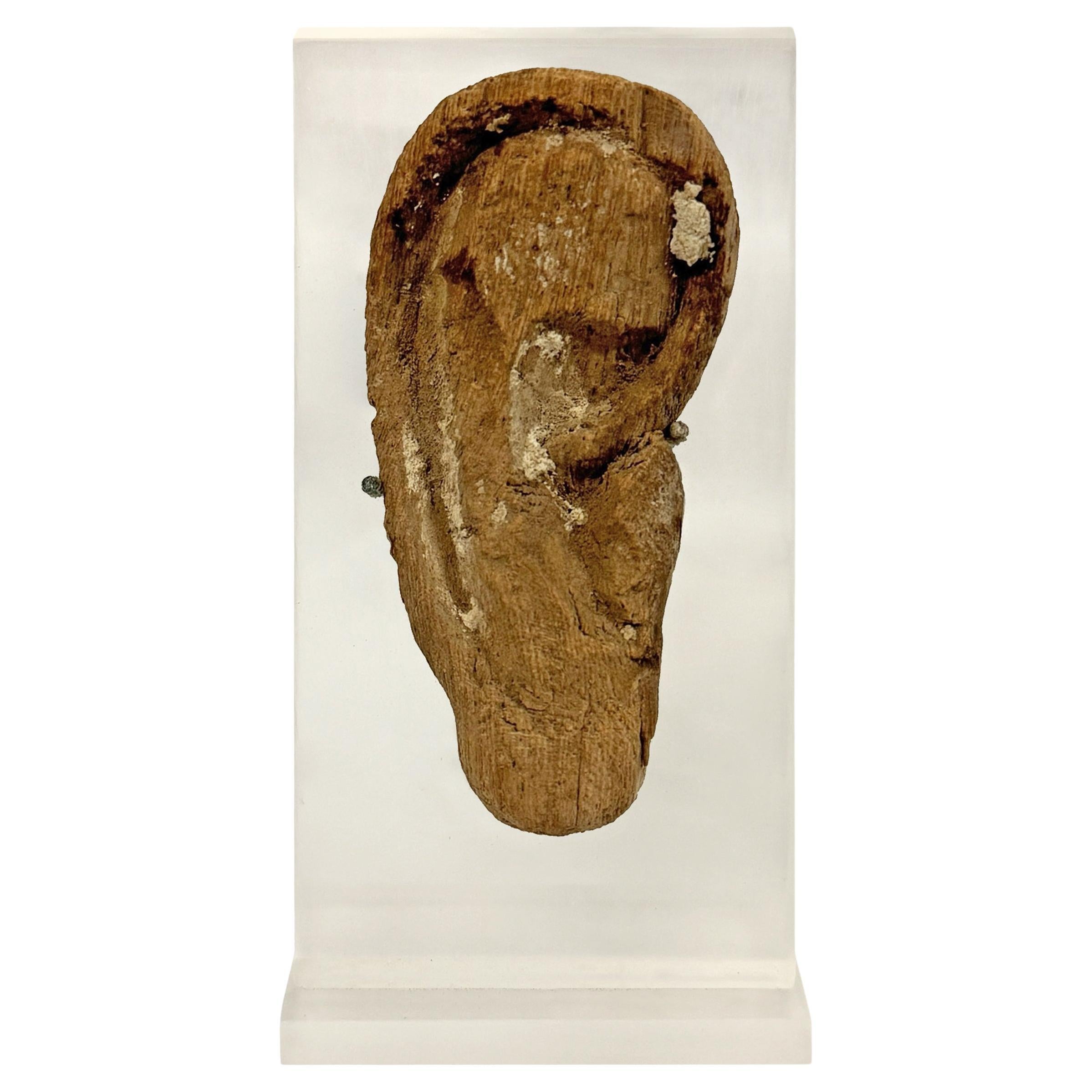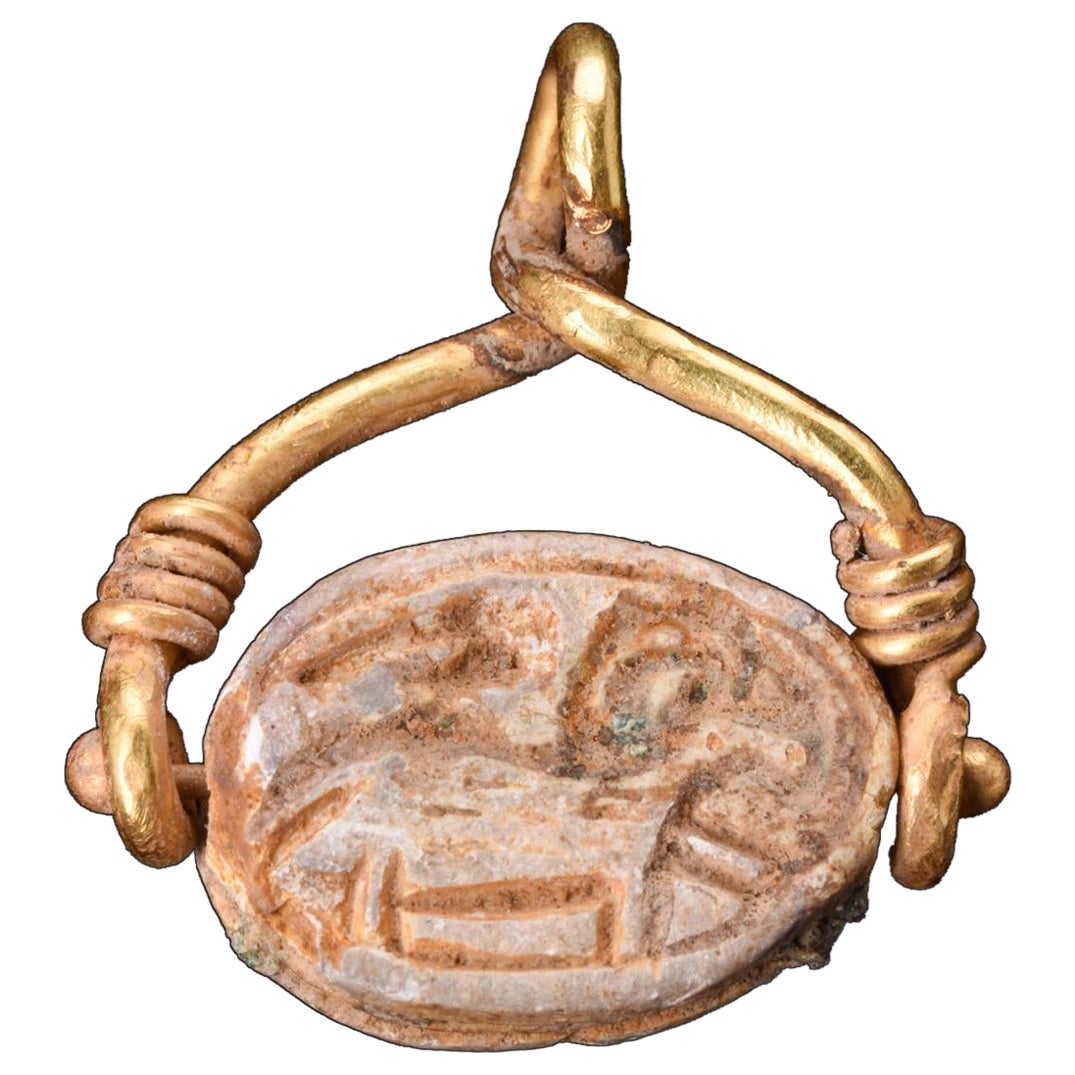Items Similar to Ushabti for Imenmes
Want more images or videos?
Request additional images or videos from the seller
Ushabti for Imenmes
About the Item
A mummiform ushabti in blue faience. Four registers of hieroglyphic characters are painted around the lower half of the ushabti, with a vertical column of hieroglyphs in the centre of the back. The inscription dedicates the ushabti to the royal scribe Imenmes, son of Pendjerty. The details of the hands and facial features are also added with black paint. The ushabti stands in typical fashion, with hands crossed over the chest, each holding a hoe, and with a seed bag over the proper left shoulder.
The name Imenmes, or Amenmose, means ‘Amen is born’. The dedicatee of this ushabti was a royal scribe from the time of Ramesses II (r. 1279-1213 B.C.). Imenmes was the son of the judge Pendjerty and Mutemonet (or Iny), the sistrum bearer of Amun, Mut, and Khonsu. He is known from several monuments, including statues now in the British Museum (EA137), the Vienna Kunsthistorisches Museum (INV 5749), and the Manchester University Museum. His Theban tomb (TT373) was discovered in 1948 under some houses in Khokha. The tomb describes Imenmes as ‘The royal scribe, whom the king appointed(?) as head of the temples, Amenmose, (born of) Iny’. This may mean that Imenmes was an inspector of temples and could explain why his monuments have been found in so many different regions of Egypt.1 Several of the objects dedicated to Imenmes, including his tomb, feature the goddess Neith in a prominent position. This could be a reference to Esna, Neith’s major cult centre and the birthplace of Imenmes’ father.
Provenance
Previously in the Private Collection of General Antoine-Joseph Veaux (1764-1817), France, acquired while on the Egyptian expedition with Napoleon Bonaparte.
Private Collection of Pierre Coste, France, acquired from the above in 1798.
Thence by descent to his daughter, Laura Gauthier.
Thence by descent to her daughter, Jeanne Gauthier.
Thence by descent to her son, Paul Henri Mollandin de Boissy.
Thence by descent to his son, Henri Mollandin de Boissy (1897-1972), Marseilles, France, accompanied by a handwritten note in 1972 or before.
Thence by descent to his daughter, Eliane Denante (d. 2022), Tarascon, France.
Thence by descent to her daughter, Sylvie Denante, France, accompanied by a signed letter & by French cultural passport 242720.
ALR: S00235321, with IADAA Certificate, this item has been checked against the Interpol database.
- Dimensions:Height: 5.44 in (13.8 cm)Width: 1.89 in (4.8 cm)Depth: 0.99 in (2.5 cm)
- Style:Egyptian (Of the Period)
- Materials and Techniques:Faience
- Place of Origin:
- Period:
- Date of Manufacture:19th Dynasty, 1290-1279 B.C., New Kingdom
- Condition:Wear consistent with age and use.
- Seller Location:London, GB
- Reference Number:1stDibs: LU5517239280482
About the Seller
5.0
Vetted Seller
These experienced sellers undergo a comprehensive evaluation by our team of in-house experts.
Established in 1910
1stDibs seller since 2020
- ShippingRetrieving quote...Ships From: London, United Kingdom
- Return PolicyThis item cannot be returned.
More From This SellerView All
- Statuette of the Goddess NeithLocated in London, GBBronze statue of the goddess Neith, striding, her left foot extended forward. Her left hand is extended forward and formally held a papyrus sceptre, a fragmentary ankh is visible in her right hand. She wears a close-fitting sheath dress, incised with a broad usekh collar, and carefully engraved bracelets and armlets. On her head is the Red Crown of Lower Egypt, decorated with vertical striations and restored spiral and spire. Her face is finely molded, with a broad upturned nose and electrum-overlaid eyes and eyebrows. Neith was one of the earliest recorded gods in the Egyptian pantheon, worshipped from early in the Predynastic era through to the arrival of Roman rule. A war goddess and goddess of weaving, she was the patron goddess of the Red Crown of Lower Egypt and the city of Zau (Sais, in the 5th Nome of Lower Egypt) in the Delta. A powerful and popular goddess, she was, according to the Iunyt (Esna) cosmology, the creator of the world and the mother of the sun, Ra. This made her the mother of all of the gods, who often came to her to settle their disputes. Her symbols are the bow and arrows and a sword and shield as a war goddess, a weaving shuttle as a funerary goddess, and the Red Crown of Lower Egypt as the goddess of creation and mother goddess. She is usually depicted as a woman wearing the Red Crown of Lower Egypt, however, she is occasionally depicted as a cow in connection with her role as the mother of Ra. The use of electrum, a naturally occurring alloy of gold and silver sometimes called ‘green-gold’, for the eyes speaks to the high status of the object. Electrum had been used by the Egyptians since at least the 3rd millennium B.C., but, give its rarity, was reserved for the most expensive and important objects. Most electrum used in Egypt was imported from Nubia, though some was found there. Published: Parke-Bernet Galleries, New York, February 25th, 1971, no. 70, illus. Sotheby’s, New York, June 5th, 1999, no. 31, illus. David Aaron Ltd...Category
Antique 15th Century and Earlier Egyptian Egyptian Antiquities
MaterialsBronze
- Megalithic StelaLocated in London, GBA tall anthropomorphic stele of carved granite, divided into two distinct regions of the body and face. The body is a single unarticulated block, but the facial features are outlined...Category
Antique 15th Century and Earlier European Antiquities
MaterialsGranite
- Bronze SirenLocated in London, GBSirens were dangerous bird-like females who tempted sailors with their hauntingly beautiful song. In Homer’s Odyssey (XII, 39) Odysseus and his sailors were warned about the lethal c...Category
Antique 15th Century and Earlier Greek Classical Greek Antiquities
MaterialsBronze
- Two Glass Inlay PairsLocated in London, GBTwo pairs of two halves from the same bar, finely detailed, with pointed ears and eyebrows, opaque yellow face, opaque red on the mouth, nose, eyes and ears, translucent cobalt blue edges to the mouth, nose and ears, with translucent emerald green leaves above and between the translucent cobalt blue brows and eye line, translucent pink pupils, with translucent cobalt blie and opaque white snake scales below the face, in translucent cobalt blue matrix, cut in the lower part of a cartouche design. These rare heads might represent the Agathos Daimon, the tutelary deity of Alexandria, who was also identified with Serapis, the male counterpart of Isis-Thermouthis (who in turn was a graecisized form of the early snake harvest goddess Renenutet). In a statue of Isis-Thermouthis in Alexandria museum (no. 25773, ex-collection King Farouk I), reproduced in Gotten, Pharaonen, no. 151, the snake goddess...Category
Antique 15th Century and Earlier Egyptian Antiquities
MaterialsGlass
- South Arabian Head of a WomanLocated in London, GBA female head finely carved from evenly-coloured cream alabaster. The face features a strong chin, high rounded cheekbones, and large elliptical eyes deeply inset for inlays. The remains of the nose indicate that it was long, thin, and roughly triangular in form. A small, round mouth sits just below the nose. Deeply incised eyebrows follow the shape of the eyes, which are framed by unusual grooved canthi on either side, possibly to represent cosmetic eye paint. The supraorbital margins above the eyes are deeply carved, while the carving below the eyes is more subtle, smoothing the sockets into the rounded cheeks. The ears are formed from two arcs and a central sphere, and both lobes are pierced for earrings. The long hair frames the face below the ears, and is carved to create a rougher texture. There is a stock sticker on the back of the neck. A fragment of the right shoulder remains. This suggests that the head was part of a larger sculpture, possibly a full figure (though this seems unlikely due to its relatively large scale) or, more likely, a bust. This head is stylistically aligned with those found at Timna, the capital of the ancient Yemeni kingdom of Qataban, which existed from the 1st millennium BC until the late 1st or 2nd centuries AD. Timna served as an important hub of the Incense Route, the camel caravan that transported incense from Arabia and India to ports on the Mediterranean Sea. Roman author and philosopher Pliny the Elder (23/24-79 AD) described Timna as a busy city with around 65 temples. Excavations in 1950 and 1951 by Wendell Phillips...Category
Antique 15th Century and Earlier European Antiquities
MaterialsAlabaster
- Bronze HoardLocated in London, GBDagger L: 27.8 cm, Luniform bronze, possibly a belt buckle L: 10.8 cm, Shield-shaped bronze with a point Diam: 6.5 cm, Pommel Diam: 3.7 cm, Violin-bow brooch L: 17.5 cm, P-Shape...Category
Antique 15th Century and Earlier European Classical Roman Antiquities
MaterialsBronze
You May Also Like
- An Egyptian wooden female offering bearer figure, Middle KingdomLocated in UTRECHT, UTStanding female wearing a tight fitting white dress and black tripartite wig, serene facial features with large painted eyes. Separately made arms attached with dowel to the shoulder...Category
Antique 15th Century and Earlier Egyptian Egyptian Antiquities
MaterialsWood
- An Egyptian alabaster ribbed cup, New Kingdom, 18th dynastyLocated in UTRECHT, UTThe cup hand-carved from white alabaster with caramel and white veining throughout the composition. The cup stands upon a tapering base, and widens to form the ribbed, cylindrical cup. Alabaster was a material prized by ancient sculptors...Category
Antique 15th Century and Earlier Egyptian Egyptian Antiquities
MaterialsAlabaster
- Late-Period to Ptolemaic Period Egyptian Wooden Mummy Mask Ear on Custom MountLocated in Chicago, ILThis Late Period to Ptolemaic Period Egyptian carved wood ear, once part of a mummy mask, stands as a poignant testament to ancient Egyptian customs and beliefs. Dating back over 250...Category
Antique 15th Century and Earlier Egyptian Egyptian Antiquities
MaterialsWood
- Swivel Gold Ring with Egyptian ScarabLocated in London, GBAn Egyptian steatite scarab encased in a possibly later, high-karat gold swivel ring. The scarab is a symbol of rebirth and protection and is decorated with six sacred serpents, repr...Category
Antique 15th Century and Earlier Egyptian Egyptian Antiquities
MaterialsGold
- Egyptian Steatite Scarab in Gold PendantLocated in London, GBAn Egyptian steatite scarab with incised features and hieroglyphs to the reverse. The front anatomy features a detailed head and clypeus with incised linear decoration to mark the prothorax and elytra. The reverse side is hard to distinguish. Mounted in a high karat later gold swivel pendant...Category
Antique 15th Century and Earlier Egyptian Egyptian Antiquities
MaterialsGold
- Customs officer's walking stick for goods inspection, Germany, 1870.Located in Milan, ITSystem walking stick: Probing stick, used by customs officials to push bales of cotton or other goods, looking for items on which a duty was to be paid. Bamboo wood barrel, silver kn...Category
Antique Late 19th Century German Antiquities
MaterialsSilver, Iron





